The 50 States Project is a yearlong series of candid conversations with interior designers, state by state, about how they’ve built their businesses. Today, we’re chatting with Dallas designer Juliana Oliveira of Beyond Interior Design about how she overcame her fears about sending big bills, why she became a general contractor, and how she’s tapping into a new clientele niche: pro athletes.
You come from a family of architects and engineers, but what was your path to the industry?
I’ve always been around construction and design in some way or another [because of my family]. I had been doing visual merchandising for five or six years when I decided to go back to school. I always loved design, but it was something that came so easily—it felt like it was too easy to be a career. Everybody knows how to do this, right? Like, I shouldn’t pay for an education in this. So I went to architecture school.
I started taking on projects [during school] to build a portfolio, because I knew I wanted to have my own business at some point. I did a project here and there, and it just snowballed. Before I knew it, I already had a business on my hands.
That’s amazing. What was the moment when you truly launched your firm?
My first client was somebody my mom met. She said, “This lady sounds like she wants the style that you have, and I keep telling her, she just needs to hire you.” This client had gone through three designers and couldn’t get what she wanted. She wanted something really modern—this was 10 or 11 years ago, and at that time, [that look] wasn’t very popular in Texas. But being that I come from Brazil, I’ve had a lot of modern influences in terms of design. And it turned out to be a great fit.
I started doing her living room, then her dining room, and then it just escalated and I did the whole home. I got a second client with a new house, and they wanted everything done as well, even the kids’ bedrooms. After that, I started to realize that if I was going to be working for people who were going to be paying me, I needed to have some kind of structure and a contract.
Wait, that means you did two huge jobs without a contract?
Yes, I did. I mean, we had agreements in terms of, “This is what I’m going to do, and this is how much you’re going to pay me.” But to be completely honest, I didn’t have the insight that I have today. So to me, what could have gone wrong? Luckily, they turned out well—as a matter of fact, I’m working for both of those clients today with new homes, and I just heard today that one of them is going to get published in one of the Dallas magazines.
Congratulations!
Thank you. It was trial and error. I’m really good with managing relationships with people—I can talk to anybody, and I’m great in terms of problem-solving, so as problems arose, I worked through them and that’s how I learned what to do with the next client. I did a little research [after those first two projects], got an LOA, opened a bank account and got some business cards.
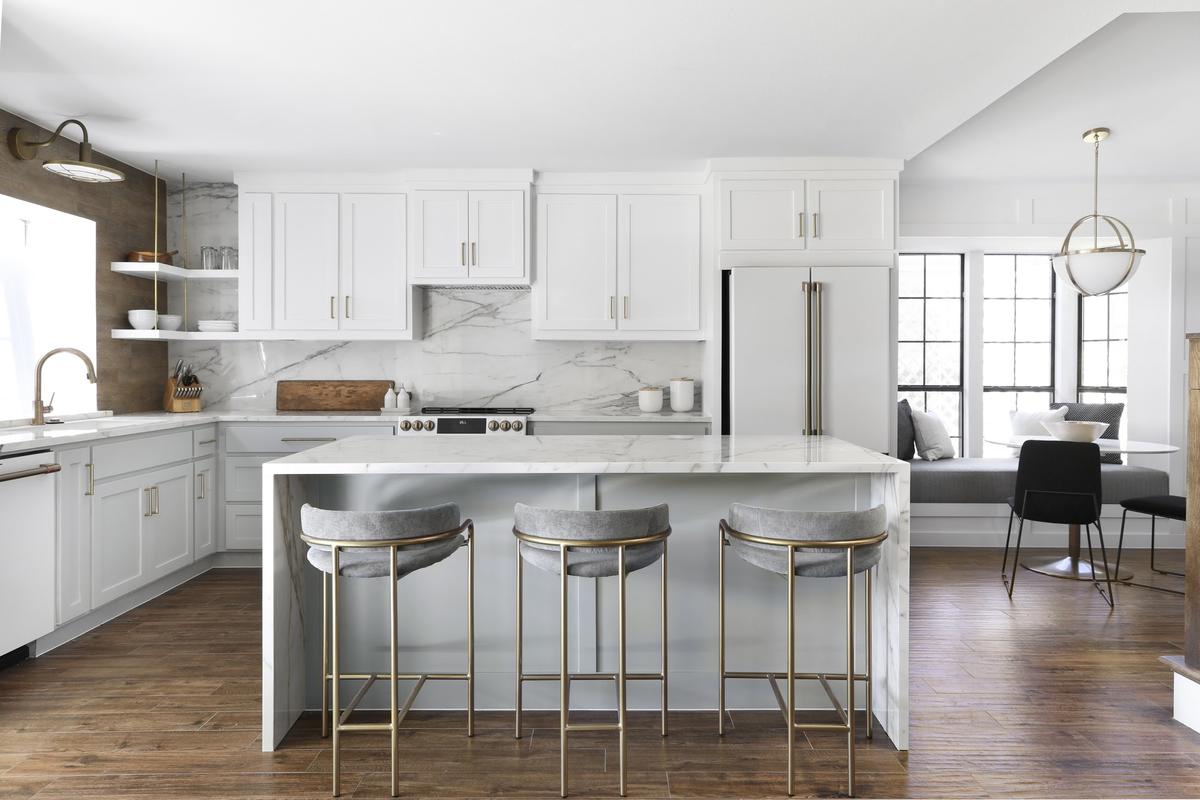
How much of your contract is still a living, breathing document as you learn from each project?
I would never say that it’s set in stone, because, especially working in residential, every project may bring new challenges that you haven’t thought about before. We’re constantly making edits. Sometimes it’s a little thing—for example, we take a deposit upfront, which we used to call a retainer. Now we call it a deposit because we found that it was cleaner for the client. We’re constantly reevaluating.
How big is your team today?
Right now we have 12 in the office—four designers, including me, and then four design assistants and contractual team members, as well as four external consultants who don’t work in the office but are an extension of our team.
How did you grow over time—and where did you make your first hire?
When I set out to start a business, I thought I wanted autonomy. I had all these creative ideas I wanted to implement, and I wanted to make my own decisions. I really wanted to create a job for myself. But as I took on more projects, I realized how much work it was and I knew I was going to need to hire help to do the things that I wasn’t good at and that I didn’t care to do. I was five years into it when I made my first hire: an assistant. Within two years, I hired an expediter to help with vendors and purchase orders, and then I hired a bookkeeper. It was me plus three for a long time.
Things started to change after I had my first son two years ago. I had a moment to really step back and reflect. I kept thinking, What am I doing this for, and what is my end goal? After some soul-searching, I realized that I wanted to be big. I wanted to grow the firm and create a company that people would want to work for and with. With that vision, I took the next step and hired my first designer two years ago—not an assistant, but an actual designer. Today we have four designers, four design assistants and a whole support team.

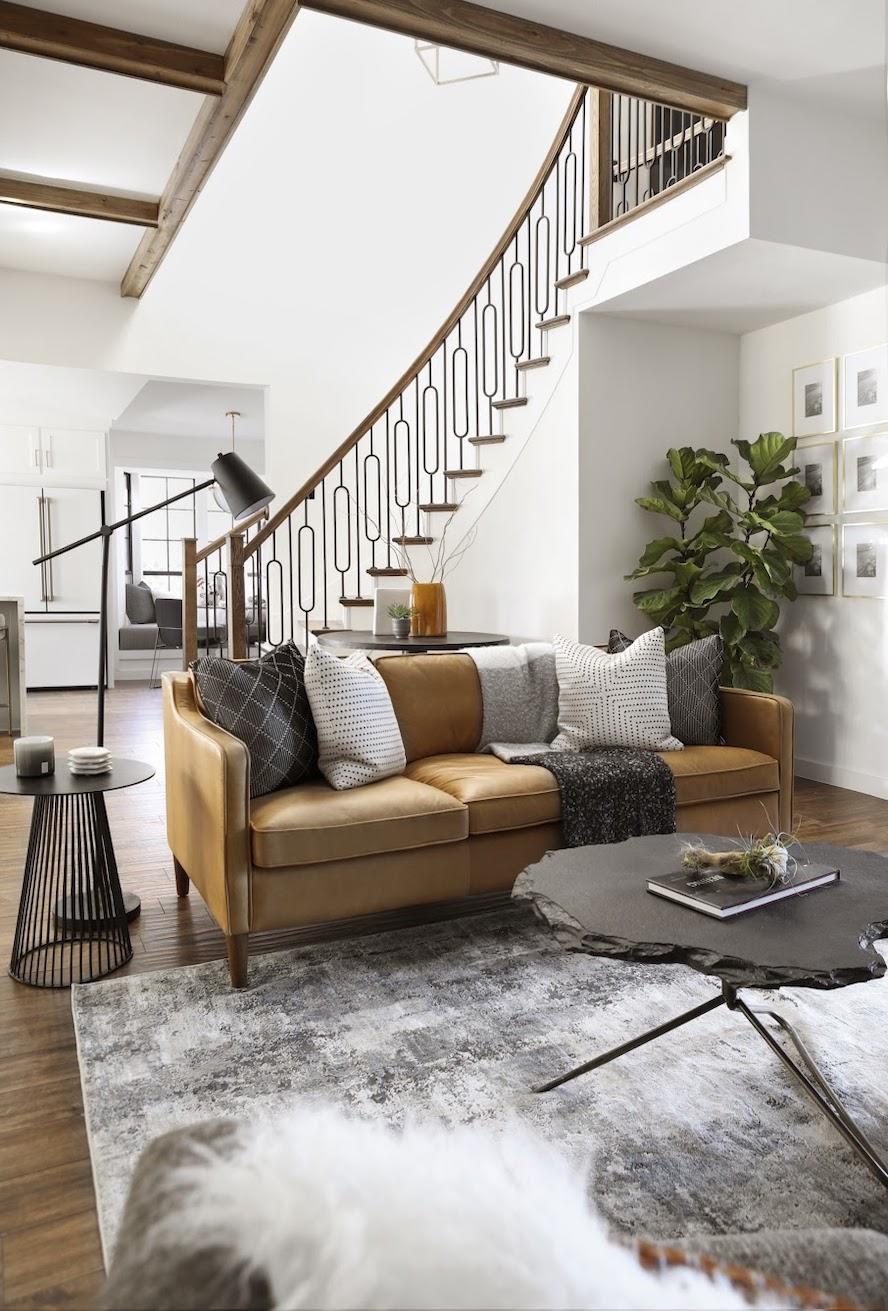
That’s a huge leap of faith to hire someone who’s an extension of you. How do you find the right people for that role?
It was really scary to think about training somebody and relying on that person to have the same perspective and vision that I have. My thought was, I need to hire people that are better than me—because that will help me grow as well, and that’s only going to make the company better. It was a leap of faith, but I was excited about doing it.
The lack of ego in what you just described is so remarkable.
I know what I’m capable of and I know what my strengths are. I love coming up with the ideas and implementing them. I love to present to my clients and see the reaction on their faces when their spaces are revealed. But I also know I’m not the kind of person that’s going to sit behind a desk all day and do drawings. I’m not going to spend 20 hours creating a model, but I knew that I wanted to provide that for every project we do—we present with a 3D model, that’s a non-negotiable for us—so I knew I was going to need somebody who has very strong technical skills and enjoys that.
As you were redefining your role in the firm, what were the things that you wanted to make sure you kept doing?
It was important to me to onboard projects because I wanted to make sure they were going to be a good fit. I think that is a key to success. If we were taking all the projects coming into the door, we actually may not be able to take as many projects as we do because they would be extremely difficult—we may not have happy clients because they may not all be looking for what we’re setting out to do. I wanted to make sure that I was the first person that the prospective client was in contact with in terms of figuring out what they wanted, to make sure it was a good fit. That was number one.
And then number two, I wanted to be the person that sets forth the design intention—I want to be the visionary for the company, and the person that brings everybody’s ideas together and creates cohesive, innovative results that push the envelope for the client. I’ve always been about stepping back and figuring out how something can be better. I thought with more people and more perspectives, we could be even better innovators.
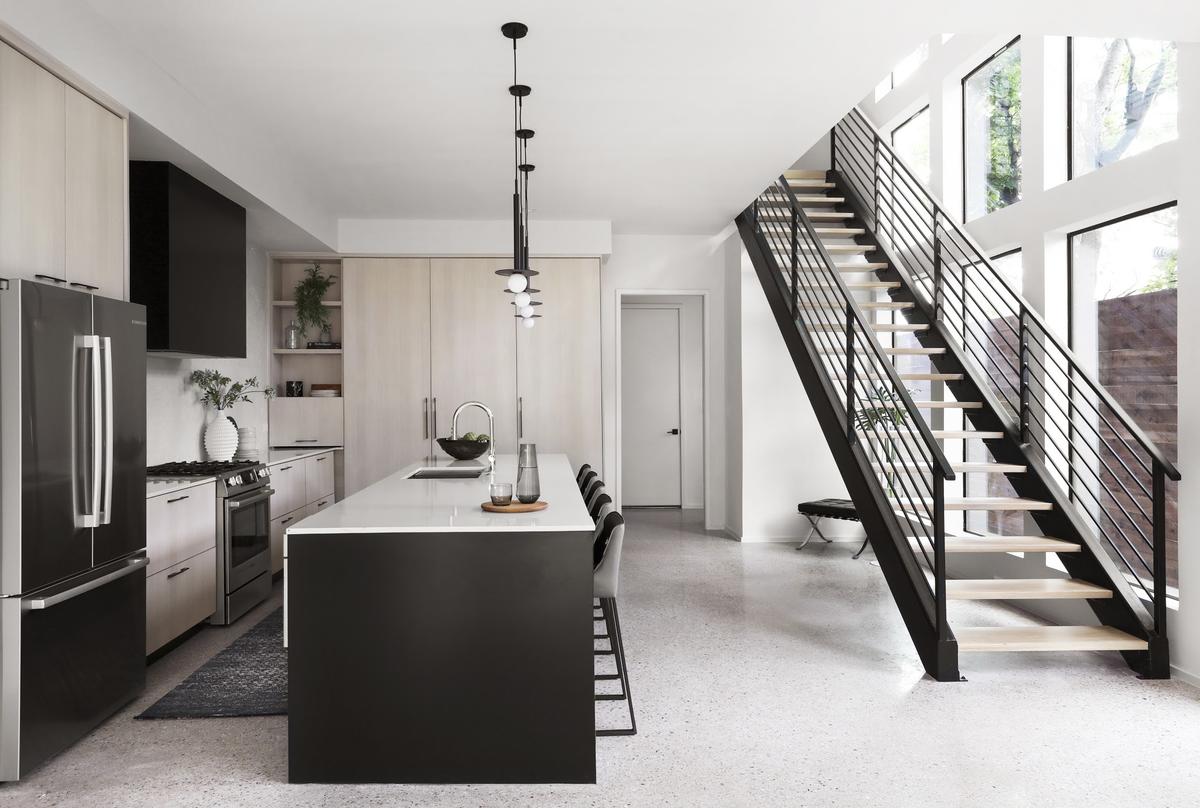
How many projects is your team typically working on at any given moment?
A normal amount for us would be 10 projects at a time. Right now we have 16, though.
I feel like that kind of scope creep is happening all over the industry right now.
A lot of it has to do with people changing what they want in their home—even mid-project. A lot of our projects that should have been closed are still ongoing.
Because they’re using their house differently now?
Absolutely. We did this project where we had presented everything to the client and were ready to move into the project management part of the process when COVID happened. They wanted to do half of their house: We were going to do the master bedroom, living room, bathroom, and the front entrance. But when we came in for the first day of demo, the client goes, “Can I talk to you for a second? Can you just do the whole house?”
Oh, man. That’s wild!
They were also the first clients that I had to have the conversation [about whether or not to move forward] with after everything got shut down here in Texas. They were like, “Do we do this? Do we not do this?” And I just had to remind them, “You hired me because I’m the expert, and this is my expert opinion: I don’t know what’s going to happen tomorrow, but remember that now you’re going to need us more than ever [in this environment]. You’re really going to need somebody to manage your purchase orders right now. You’re really going to need somebody to take full responsibility for the trades.” And in terms of long lead times, I told them, “I don’t know what that means—in three months or in two years—but even if it’s 2023 and we’re just starting your house, if we just keep going now, you’re still in front of the line ahead of everybody else.” I just had to put it into perspective, and they agreed. We waited a little longer just to make sure that we felt safe, that all the trades we work with felt good about moving forward, and that they could move out. That’s when we started the construction, but now we’re in the end stages.
Where do clients see you throughout the process?
That’s something I really pondered for a long time—and the cool thing about our company is that it’s called Beyond Interior Design, not called Juliana’s Interior Design, which makes it a little bit easier. I understand that when people hire us, they know that I’m the principal. And I’m going to be there and be hands on with everything, but the clients really only see me a few times.
First, the client sees me when they book the first consultation—and every project starts with that first-time consultation for two hours. Usually I take my junior designer with me, and now that the team has grown, I’ve been taking different designers with me, depending on who I think it would be a great project for. Whatever my gut tells me, I’ll take them. And then if it ends up that they’re not going to be the lead designer on that project, that’s still fine, but they’re the ones that take the notes during that meeting. I also go through the contract with them line by line that first day we meet so there’s no questions. Typically, that’s where the client says, “I’d like to hire you,” or “Let me think about it.”
Once they sign a contract and put the deposit in, we schedule a trade day. That’s when we come in to do a deep-dive: We take all the measurements and start creating the model. They’ll see me then—usually I’m there for about an hour to get the team started, to ask whether the client has any additional questions, or if they thought about anything else they want to ask. I’m there to solidify the scope at that point. The team is usually on-site for eight hours to get everything they need, but I’m just there for an hour. And after that, the next time the client sees me is at the presentation six to 10 weeks later.
What is that presentation like?
I present things holistically, so it will include a floor plan, a design concept and the actual model. We make all the decisions for the clients, we get all the quotes and have all the samples [on hand], so it’s a really intense orientation. But when the client sees that we’ve actually thought things through, they really value the decisions we’ve made and tend to just go with it.
And even though it’s only their third time seeing me, the lead designer on the project does a follow-up with the client on Fridays every week. They are hearing from us throughout the process, but it won’t be from me in particular. I chose to do that very intentionally—to create the relationship between the client and the lead designer so they can feel at ease and have candid communication. It also creates a little bit of a barrier between them and me so that when I do step in, they take what I have to say seriously.
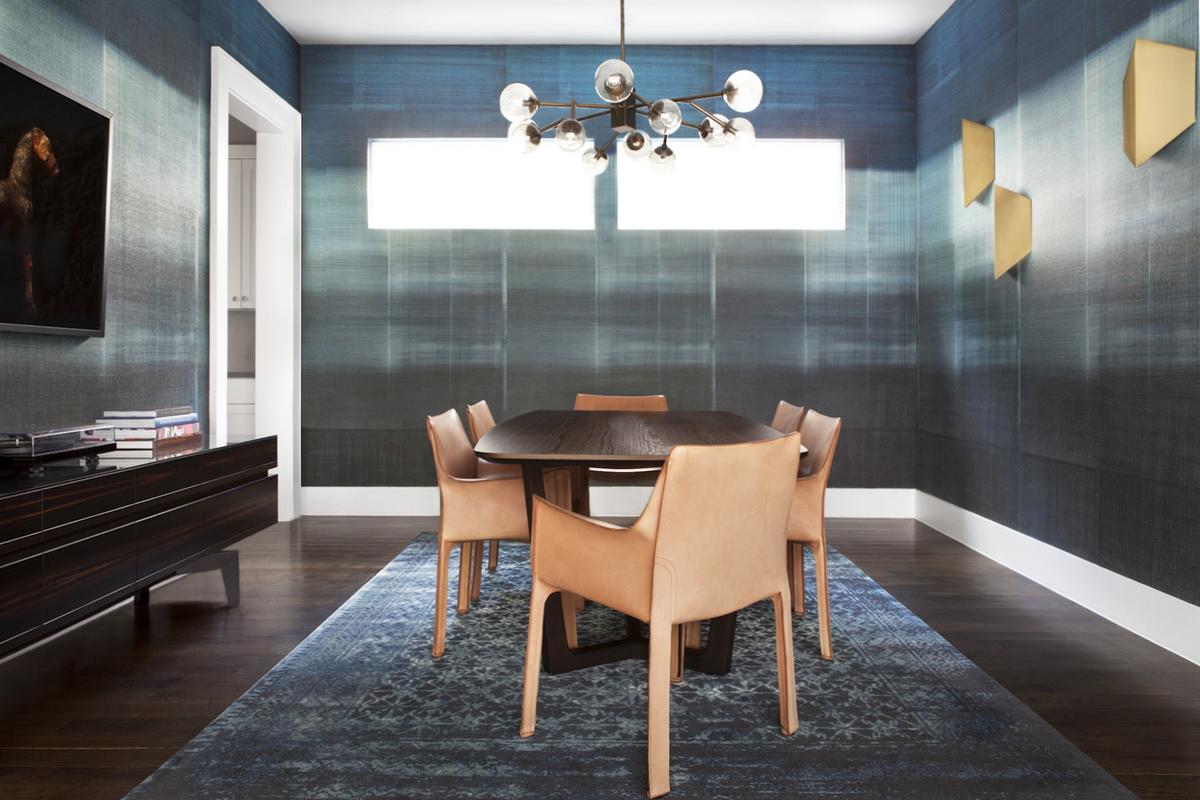
Does that extend to all corners of the business?
Yes, it’s the same thing with accounting. I’m not calling on them to collect money—I have a bookkeeper and an accountant in-house to do that. Or if the client is acting outside of our contract, Sarah, who’s our compliance officer, gets involved. It has created a smooth process where the client understands what everybody’s role is—and what my role is as the expert.
How did you land on that structure?
It came from working by myself, and then with a couple of assistants—it was me for everything, and it was really stressful. And the clients start to lose track. They can’t see you as the expert anymore.
Because you’re all the other things too?
If somebody doesn’t show up, I’m the one over there steaming the curtain. Suddenly, I’m the errand person as much as the designer. I had to figure out how to create that separation. Part of that is billing hourly too—we’re really transparent about our billing and we turn all of our time sheets over to our clients every month when we send them a bill, which is an educational process for them.
They’re seeing the two hours it took to source a lamp?
Yes. And they’ll see on Tuesday from 10 a.m. to 4 p.m., we were building the model—we created the bed, the light fixture, every little thing. We try to be as descriptive as possible, because I think it goes a long way in educating the client on what it takes to move the project forward. And I think it means they’re happy to only see me a few times throughout the process because they see that they’re paying me the highest hourly rate.
Of course I’m going to set forth the direction, I’m going to revise everything, I’m going to be part of the decisions—but if there’s something that my junior designer can do, I’m going to give that to them. If there’s something that the design assistant can do, then the junior designer is going to be sending that off to them. We value the client’s money the same way that they do, and want to give them the most value with investment that they’re making. We can put them at ease that we’re not just frivolously like, “I like to shop, so I’m going to be shopping for you!”
Does seeing that level of specificity on the bill ever backfire?
No, but I was afraid of that for so many years.
Designers have told me that they’re afraid the client will see that, for some items, it took more billable hours to find the object than the object itself costs.
I can totally relate to that—it took me a long time to get here. Then I hired a business coach who told me those fears were just in my head. Now, I explain to clients that billable hours are any hours that push the project forward. It’s in our contract that we send out all the bills on the first of the month, and then they have until the 10th to come back to us with any concerns, and we’re available at any time to go through anything—we want to make sure they’re happy with what they’re getting—and I’m not exaggerating when I say I’ve had no clients ever say anything [about our hours].
Nothing?
Clients sometimes freak out because they get a really high bill, but in the consultation I let them know that they are going to see higher bills in the beginning, and then it’s going to get better—that it’s because we figure everything out before the presentation. After that, everything’s figured out and we don’t have to go back and rework anything.
So then it slows down a little bit.
I actually said this a couple of months ago to one of our clients. I sent her a message that was like, “This is going to be a higher invoice, but I just want you to know you’re not going to have any other invoices as large as this one, I promise you that.” And she had no problem, and she paid it right away—I think it was like $17,000 for one month. And look, when they haven’t seen anything and you ask them to pay that, it can be scary. You’re like, What are they going to think? What are they going to say? As design professionals, we tend to think, “If the client sees that it took me five hours to find a lamp, are they going to think that I don’t know what I’m doing?” I think we question ourselves that way. But the reality is, that’s how long it takes to find the right lamp.
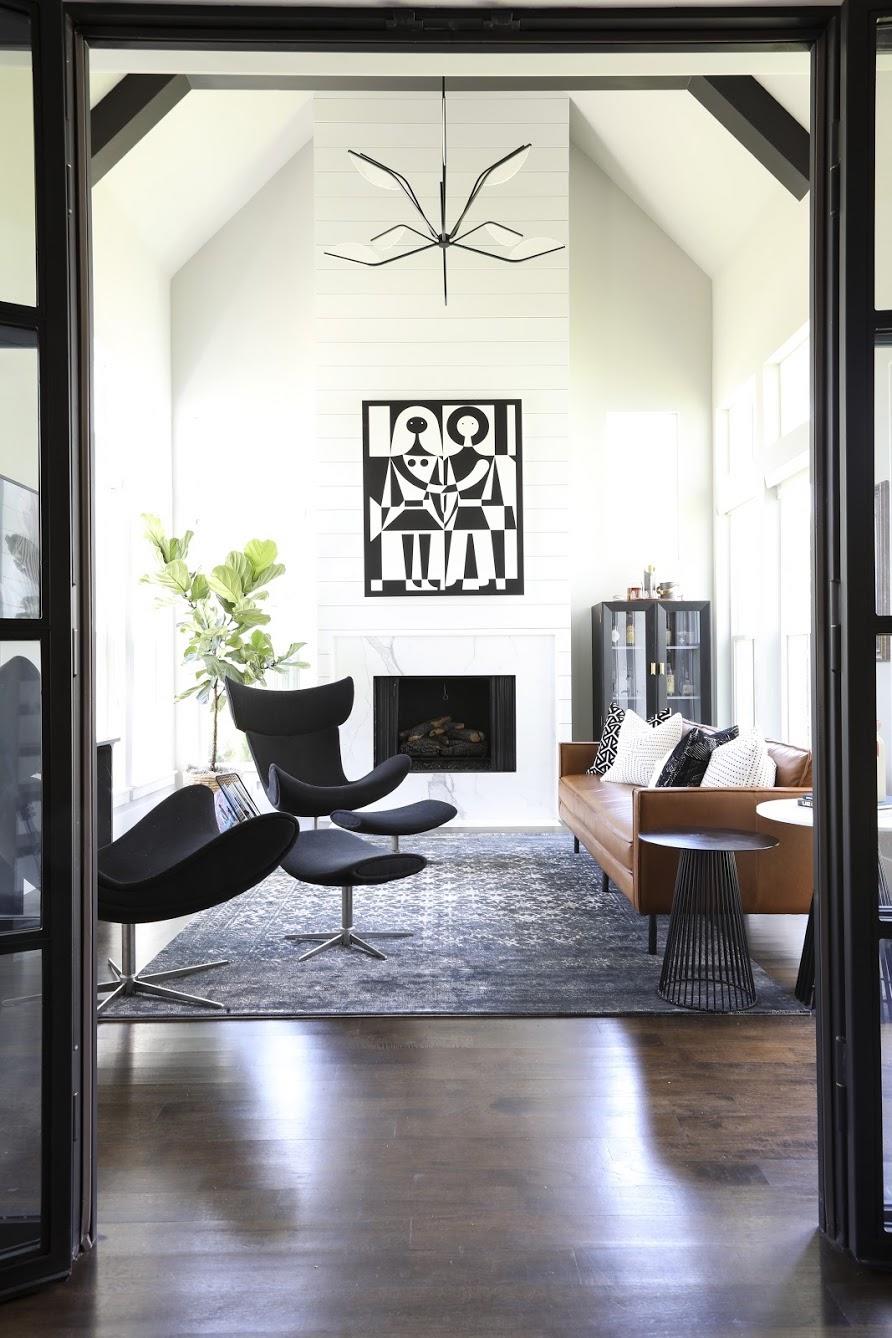

Where does that deposit fit into the process?
We have a minimum deposit of $8,000, but there’s no set amount. I explain that it’s like renting an apartment and paying the last month’s rent. Because we bill hourly, I could work an entire month and then send you a bill and you say, “Nope, not paying it.” That puts the risk on me. But if somebody is hiring me for my expertise, I should not be taking the risk. If they’re not happy with something and we part ways, that’s understandable, but we should still be paid for our time.
In our contract, we also put that if for some reason you don’t pay one month’s bill—people have emergencies, maybe you’re out of town, maybe you’re getting a divorce, things happen. Life happens, and I didn’t want to have to put an entire project on hold because of one month’s bill, so that retainer helps me carry through. After the one month they haven’t paid, we continue to work until the second month’s bill is due. That’s when we stop and put the project on hold—and because we take the deposit upfront, we’re covered.
How do you calculate the deposit? Is it based on the size of the job?
Yes. I try to make it whatever I think two months of bills are going to be for that project—but I’ll tell you, I’m always wrong.
And then does it just come out of the last month’s bill, or do you actually write them a check back at the end?
That depends on the clients. Sometimes the project will end on the fifth and they just paid the last bill, so they have nothing else outstanding. I love writing a check at the end.
‘Here’s the beautiful house—and also, here’s the check.’ That’s got to be a pretty great feeling.
Even though it is a deposit, they’re still thinking of it as money they already spent. When I bring that back to them, they’re like, “Oh, you remembered!” It’s a really good way to end the project.
When do you bill for product, and do you also charge hourly for that expediting time?
We don’t take any money for products or construction or labor until after presentation. Sometimes it’s a four-hour presentation—we have meals and drinks, it’s a whole ordeal. We’re prepared so that at the end of the presentation, they could write me a check right there and then. We’re also prepared to make value-engineering decisions—we’ve already explored other alternatives, we have backups to the backups.
Sometimes the client is ready right away; others want to think about it a little bit more, and we give them the space, but we always, always schedule a follow-up. I don’t want the client to go into a dark room and try to make their own decisions and spend themselves out of a complete design because they’re making the wrong decisions, so we usually follow up in a week. If there are any revisions we need to go back and do as a team, we’ll schedule that and let them know it will be done in X amount of days.
Once we’ve finalized the scope and the items we’re purchasing, we send out an invoice for the product and labor. We used to ask for 75 percent upfront and the remaining 25 percent two weeks prior to installation, but with COVID, we’re doing 100 percent upfront because if I have the money on hand, I can make the decisions I need to and make sure things get shipped out at the right time. If something is being back-ordered and I had the opportunity to pull the trigger quicker on something else, I can do that if I have the money. We do bill hourly for the expeditor’s time—but we have an in-house expediter, and her hourly rate is the lowest.
Are people ready to write that check—are they comfortable with it at that point?
They are. That was another big barrier for me to get over. I was thinking, Who’s going to write me a check for $250,000? But a lot of people do, and I had to learn to get out of my own way. We tell ourselves stories that something’s not true. That might be our truth, but it’s not somebody else’s truth.
You mentioned your initial consultation—have you always charged for that?
No—that was another one where I had to get out of my head and out of my own way. Who’s going to pay for consultation? A lot of people.
It’s difficult to go through a consultation when it’s not paid because then it’s basically a meet-and-greet. It’s a waste of everybody’s time, and it allows looky-loos to just bring you into their homes. [Being willing to pay for the time] is a qualifier, and it establishes me as an expert. They know that if they want to talk to me, it comes with price tags, and it shows that they value my opinion. It also means I can spend two hours there and try to give that client as much value as I possibly can. If it is a good fit and we take on the project, great—we take all the information and all the notes and can start from there. If it’s not a project we take, they’re still getting a ton of valuable information that they didn’t have before I walked through the door.

Do you have a preference for whole house versus partial, or is it about project budget?
Honestly for me, it’s more about if it’s a good client [match]. I honestly would take a project that was just a nursery if that person values what we bring to the table, and if they understand that they’re going to pay about the same amount for fees that they’re going to spend on product. If they want us to do it because they know it’s going to look amazing and they’re willing to pay those fees, then we’ll take that on. But we’re trying to be as transparent and upfront as we can—it’s not really a matter of size or scope, it’s a matter of being a good fit in terms of our vision and our values. Our process is the same no matter what—if we do the one room or the whole house, our process doesn’t change. I’m also a general contractor here in Texas, so it’s really cool to be able to do the design and make sure that it gets brought to life in the way that we think is best. It gives me a lot more control over our projects.
Were you always the GC?
No. I partnered with GCs all of my career, and obviously found some that I really like to work with and others that I didn’t like working with. I realized that I can draw pictures all day long, but if we can’t make it happen, then it’s not working. The more the company grew and the more the jobs we got, I felt like I could only guarantee that whatever we were presenting to clients was going to look like that if I took complete control. So I still hire other general contractors to manage the projects, but I’m in charge. I can pull permits and I can fire them at any time.
Tell me a little bit about the Dallas design scene.
Dallas is always, always growing. We see a lot of people moving here from the East Coast and West Coast. There’s so much opportunity for growth, no matter how much we grow—it’s crazy! So there’s always work and people are really particular about their home. Real estate is relatively inexpensive here compared to the rest of the country, so people buy more square footage, which also means more opportunity for design.
Once they’ve bought that big house, do people have enough money left over to furnish it?
That’s always a challenge. I don’t think people understand how much it takes to actually fill up that real estate! I don’t think it’s necessarily that they don’t have the money, it’s just a matter of education—it’s just going through and showing them how much things really cost. People have more disposable income here because taxes are lower and the cost of living is lower, so it’s just a matter of showing them, This is what it would take to get to where you want to be. Once they understand, they don’t have a problem spending it.
We’re doing a project right now for a client who moved here from Chicago and bought a house that was probably triple the size of the house she had before. Her parents moved in with her, which we’ve been seeing a lot of too. The house was big enough that she and her parents each have a living room of their own. She was like, “I wanted to build something new so it would be perfect for us, but I didn’t want to wait.” They found a house that they liked for the location, but wanted to truly make it their own. I would say the home value is probably around $700,000—and we presented $500,000 in design. It takes a lot of courage to really show the client what we really think is going to be best and what the best-case scenario could be.
Because of the price tag attached?
Sometimes I struggle with that—especially when I’m presenting basically their home value in upgrades and furnishing. Are they going to think I’m crazy? I’ll be nervous before the presentation, but afterwards I realize that the client hired us for that—they want to see that, and they know that if they decide to scale things back, they can.
Where do you shop?
I am a big fan of going to markets. As a matter of fact, I just came back from High Point.
I’m so jealous! I did it via FaceTime this fall, and I wished I was there the whole time.
It was a hard decision to make—I almost didn’t go. I just hired a new junior designer a few months ago and I feel like it’s so important to calibrate everybody’s eyes in terms of what’s out there—what I like, what they like, and talk about all the findings and trends. I was missing that, especially with a newer team, so I asked who felt comfortable going and a few said they did. I decided to take them and our expediters—we actually have two people in that role, one part-time and one full-time—and I felt like it was going to be a good opportunity for the new full-time person to solidify the relationship she’s building with these brands and put a face with the name. She doesn’t come from the design industry, her background is in HR, so it was really interesting to see her reaction to everything. She was excited about every little thing.
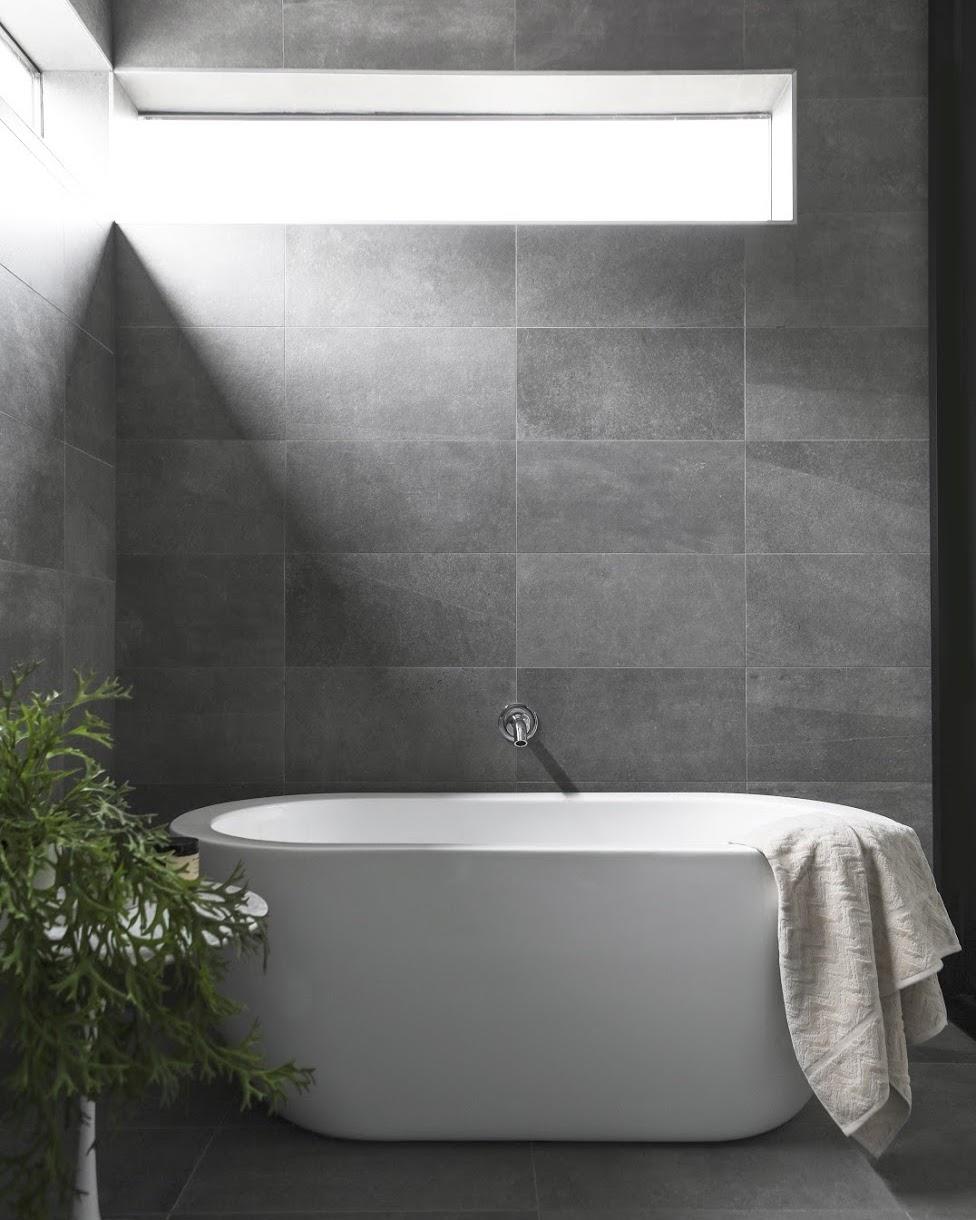
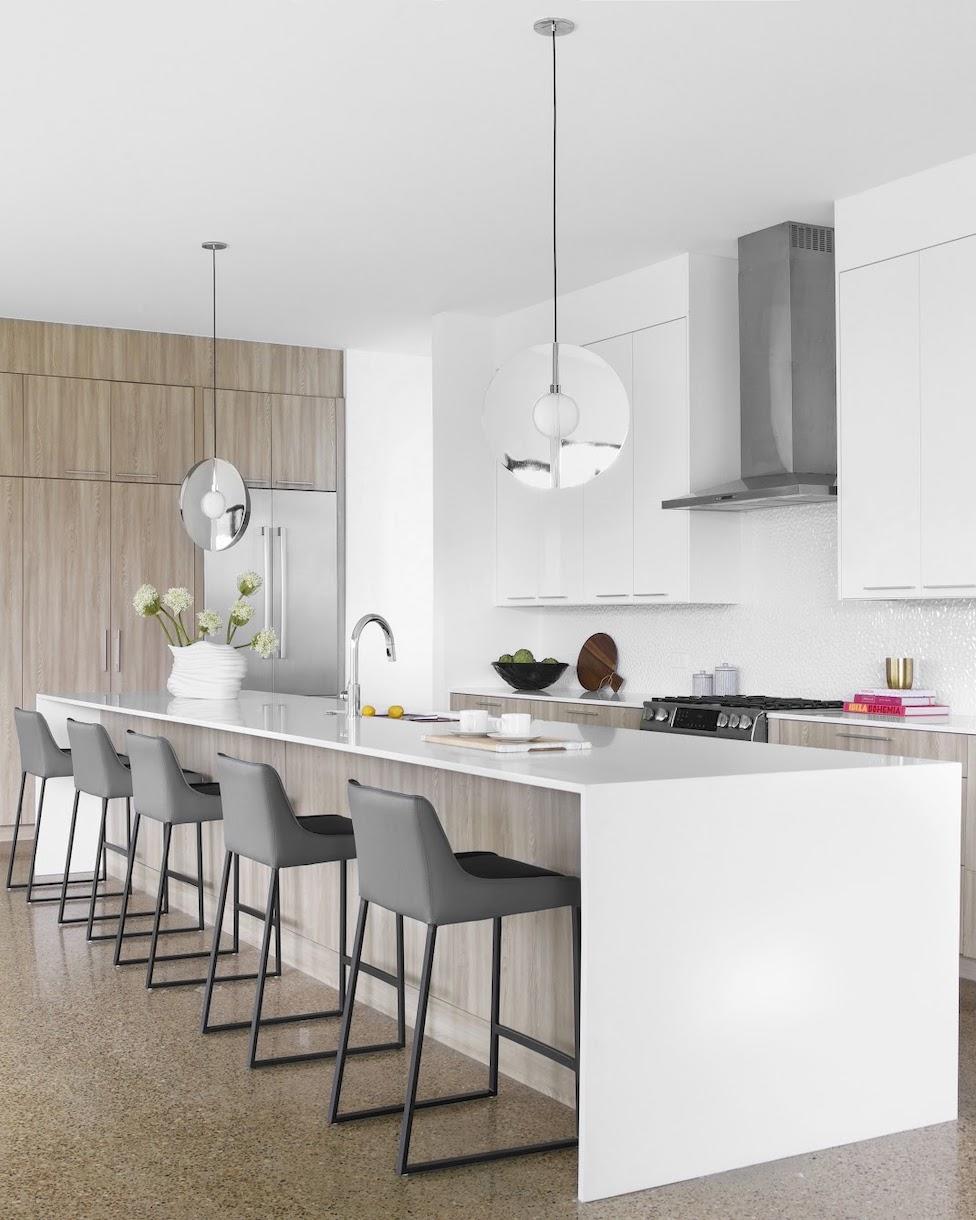
I know wellness is very important to you. How do you fold that into what you’re presenting to clients?
One of our core values is that we’re always presenting and specifying things with the client’s wellness in mind. Even if the client doesn’t ask for it or understand it, we’re always bringing materials that are nontoxic, that are not off-gassing or toxic to their health. We bring the outdoors in too—that’s a big thing for us. I grew up in Brazil, where that’s been a thing forever; when the term biophilic design came out, [it put a name to] what I’ve always been trying to do, because that’s how I grew up.
Lighting is a big thing for us as well—the temperature of the light and what we want that space to evoke. So if it’s an office space in the home, which we’ve been doing a lot lately, we want to make sure that it has the right lighting that’s invigorating and that puts our clients in the best mood for productivity. But in the master bedroom and bathroom, it’s really about relaxing them and turning that into a sanctuary at the right time. We’ve been integrating a lot of things with Control4 to make the lighting more automated for that reason.
Are clients excited about that?
We find that a lot of clients don’t even know. When we can find a vendor video that is short and informative, we like to share that with our clients—during the presentation, we’ll be like, “We just want to show you how this works.”
I’ve been talking about wellness forever, and it’s kind of contagious—everybody in the office is really jumping on the bandwagon. But when I went to KBIS this year, I realized: This is really going to take off—it’s not just me! There are a lot of people making it easier for us to specify those products and connect everything.
How do you grow that part of the business?
My sister, who’s our compliance officer, has a background in law, but also in the sports industry. The more we talked about wellness in design, she realized that [wellness-focused design solutions] are something all athletes should have. “All they do is spend their entire time training, and [in the gym] they’re all about the little things they do to enhance their performance,” she told me. “But then they go home, and their lighting is making them sleepless or sluggish? And isn’t our perfect client that one that lets you do everything?” And I’m like, yes. She said, “Athletes have all the resources in the world except for time. Why are you guys not tapping into that?”
She was able to talk about it that way because she’s not a designer and her background is in a different industry. And that’s another reason why I love hiring people from outside of design—I think people have so much to contribute when they come from outside the industry because they’ve seen other things and they see things in a different perspective.
Did you start pursuing athletes as clients as a result of that conversation?
We’ve developed a whole trademark-pending program and are in the process of presenting to a few agents and trainers; we’ve talked to several athletes; we are working on homes for two professional basketball players right now—personal homes for their families. It’s been really exciting.
Besides that wellness lens, are there other things that are different about working for an athlete than with another client?
The whole wellness thing has given us a little bit of an edge because we’re turning their homes into a recharging station, and that speaks to them. The other thing is, again, they have all the resources in the world except time—and they get moved around a lot, they get traded. I’m friends with several professional athletes, so I sat down with a lot of them friend-to-friend to understand some of their pain points when they were going through that. One friend played in the NBA for five different teams, and I could see the emotion when he talked about being traded and how frustrating it was. One day he was having a house-warming party with his teammates, and then the next day he’s on a plane going to a new city, where he lived in a hotel for months.
That must change how you think about home too.
Totally. And that’s the thing—they don’t have anybody that they trust to get their home started [in a new place]. Even if they hired somebody, to get them up to speed requires a huge time investment, and they don’t have that.

Are you about to fast-track that process for those clients?
Yes. We do a consultation—we don’t put a time limit on it because it varies from person to person how they prefer to have that conversation—but basically we do an in-depth investigation from day one. We get their thoughts, ideas, must-haves, anything else they want to share with us. If it means spending a day with them, great. If it means I have 24 minutes to learn as much as I can, we make that work too. If they want us to work with their wives, we can; one of the athletes had us work with his mother because he’s not playing here in Texas, but he is building a house to come home to Texas.
The whole point is that we always get to know our clients—but especially with the athletes, we get to know them and then we take the lead on everything. They write us a check, we expedite everything, we get everything done. And for the athletes, we extended our services to include a concierge service as well. We have a phone line that’s strictly dedicated to athletes and anything that they need. If they need a chiropractor, we have a service that will connect them to the right people and schedule appointments.
We’ll provide maintenance for them too, if they’re not living here full-time. Whenever they’re coming, the house is maintained, the fridges are stocked, they have clean towels. Or if they’re having a party, we can get all that set up too. We offer management as well, so if they got traded somewhere else and wanted to lease or sell their house here, we’d handle everything for them. And if they go to another place, we have an inventory of everything they own and we can be there within 24 hours to scout out the new place and make it feel like the home we created for them in the first place. That means re-implementing everything from the first design, but also making it feel fresh. At that point, we know what they like and we know what makes it home for them.
So this is an ongoing, billable relationship?
Yes. The process for the design part of it is the same as all of our other projects, and then we have one person that is in charge of managing the rest. Eventually, that’s going to grow into a team once we develop that side of the business. We have a partnership with a concierge service as well, which is how we are set up to be their trusted resource for anything that has to do with their home and where they’re living.
I feel like this program plays so deeply into the way you named your firm. I mean, your business is literally called Beyond Interior Design. Was this always how you envisioned growing?
When I named the company, I just knew that I wanted to name it something that could be bigger—something that was going to be more than just me. But it’s kind of crazy how we really grew into the name.
Where do you see the biggest opportunity to grow?
When I think about our future and growth, I have the desire to have a big company and a big team. I want to bring people along who are going to add value and be better than me, or who could show me things. I leave a lot of opportunities for the team to collaborate. And when we do meetings, I’ll stop and say, “So what do you guys think? How can this be better? Is this working? Is this not working?” We’re always reevaluating things and we’re always challenging each other too. Even if one person’s the lead on a project, we’ll bring in the other designers to get new perspectives, especially as we’re making final decisions—that’s really important to me. I want to make sure that, even as we grow our company, it still has that culture.
To learn more about Juliana Oliveira, visit her website or find her on Instagram.




























